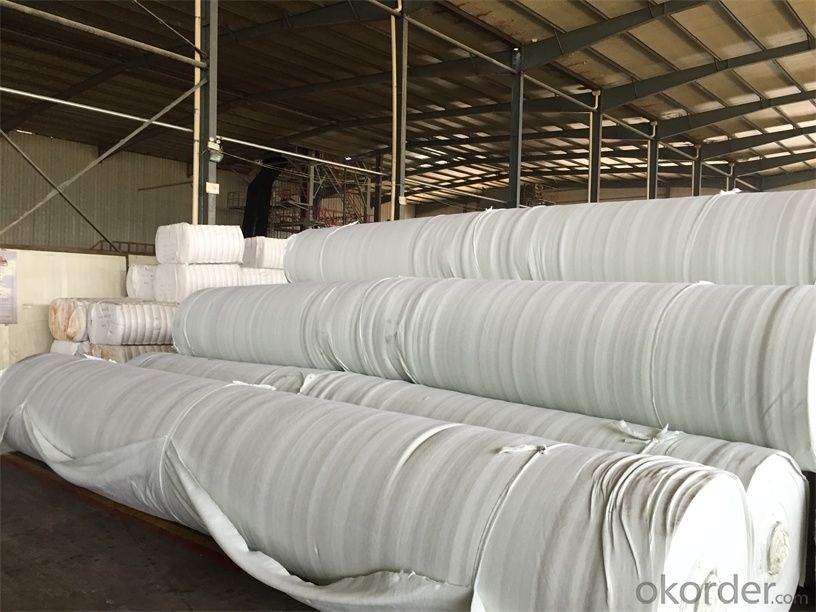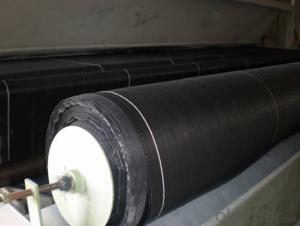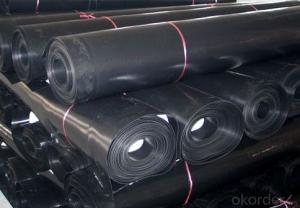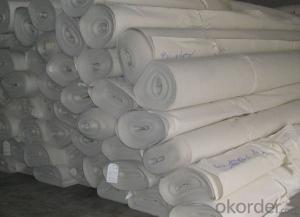PP Woven Geotextile for Road Construction Project
- Loading Port:
- Qingdao
- Payment Terms:
- TT OR LC
- Min Order Qty:
- 20000 m²
- Supply Capability:
- 1500000 m²/month
OKorder Service Pledge
OKorder Financial Service
You Might Also Like
Specifications of PP Woven Geotextile for Road Construction Project:
-Weight / Mass: 75g/m2-800g/m2 .
-Width: Within 8 m (1m-8m).
-Length: 50m-100m/roll (as request).
-Material: PP/PET.
-Color: Black , white , grey, others
-Certificate: CE/ISO9001, ISO14001 .
-Manufacturing method: nonwoven / woven.
-The equipment is introduced from Germany.
-This geotextile can be made of polypropylene (PP), or polyester (PET), Polyvinyl or synthetic fiber on needle punch machine.
-The mass is available from 75g/m² to 800g/m² and the width available from 1.0m-8m, monolayer or multilayer (reinforcement geotextiles), long fiber or short fiber.
-Color: all kinds of color are available. The annual production ability is 10 million square meters.
-The fabric can also be heat treated by infrared at customer's requirements. Our geotextile are UV stabilized to give protection against aging under exposure to natural ultra-violet light.
Introduction of PP Woven Geotextile for Road Construction Project:
Geotextiles are composed from synthetic polypropylene/polyester fibres through a mechanical process of needling the fabric and adding, when necessary, a thermo fused process, resulting in a uniform porous structure with excellent tensile strength and chemical deterioration. Type: 1. Wovens & knitted: use various fibre types (e.g. monofilament, multi-filament, split extruded film) in different combinations. 2. Non-wovens: staple or continuous fibres that are heat treated or needlepunched to “fix” fibres relative to each other.
Technical Parameters of PP Woven Geotextile for Drainage Function:
100 | 150 | 200 | 250 | 300 | 350 | 400 | 450 | 500 | 600 | 800 | NOTE | |
BASIS WEIGHT TOLERANCE (%) | -8 | -8 | -8 | -8 | -7 | -7 | -7 | -7 | -6 | -6 | -6 | |
THICKNESS ≥MM | 0.9 | 1.3 | 1.7 | 2.1 | 2.4 | 2.7 | 3.0 | 3.3 | 3.6 | 4.1 | 5.0 | |
TENSILE STRENGTH AT BREAKING ≥KN/m | 2.5 | 4.5 | 6.5 | 8.0 | 9.5 | 11.0 | 12.5 | 14.0 | 16.0 | 19.0 | 25.0 | MD&CD |
CBR PLUNGER STRENGTH ≥KN | 0.3 | 0.6 | 0.9 | 1.2 | 1.5 | 1.8 | 2.1 | 2.4 | 2.7 | 3.2 | 4.0 | |
TEARING STRENGTH ≥KN | 0.08 | 0.12 | 0.16 | 0.20 | 0.24 | 0.28 | 0.33 | 0.38 | 0.42 | 0.46 | 0.60 | |
BREADTH TOLERANCE (%) | -0.5 | |||||||||||
ELONGATION AT BREAKING (%) | 25-100 | MD&CD | ||||||||||
EOS O90mm | 0.07-0.2 | |||||||||||
VERTICAL PERMEABILITY (CM/S) | K×(101~~103) | K=1.0-9.9 | ||||||||||
RFQ:
What is the main application of Road Construction Project:
The main application of our Road Construction Project:
is as follows: The highway, railway, soil-stone dam, breakwater, airport, backfill soil of retaining wall, slope protection, etc.
Where is your main market?
Our main market is in Middle East, South America and some African countries.
What is your advantages for Road Construction Project:
One of the largest manufacturer of Road Construction Project
with advanced equipment, big production capacity and excellent quality.



- Q:Geotextile manufacturers rely on what to do a hundred years do not rot geotextile
- Because geotextile raw materials are chemical fiber. Huazhi geotextile material answer
- Q:Related applications, product applications, industrial structure and distribution
- Road cloth, that is, geotextile, also known as geotextile, it is made of synthetic fibers through the needle or woven from the permeability of geosynthetics. Geotextile is a new material geosynthetics which one, the finished product for the cloth, the general width of 4-6 meters, the length of 50-100 meters. Geotextile is divided into a woven geotextile and non-woven geotextile. Geotextile with excellent filtration, drainage, isolation, reinforcement, protection, with a light weight, high tensile strength, good permeability, high temperature, anti-freeze, anti-aging, corrosion resistance characteristics. The application of geosynthetics originated in the 1950s, the domestic geotextile is one of the national eight five plan, China promulgated in 1998, "geosynthetics staple acupuncture non-woven geotextile" (GB / T -1998) standard, the current geotextile has been widely used in many areas. Geotextile mainly in the following three series: 1, acupuncture non-woven geotextile, specifications 100g / m2-600g / m2 between any choice, the main raw material is the use of polyester staple fiber or polypropylene staple fiber, made by acupuncture, Uses are: river, sea, lake embankment slope protection, reclamation, wharf, ship lock flood control and other projects, is through the filter to play a soil and water conservation and effective way to prevent piping. 2, acupuncture non-woven and PE film composite geotextile, specifications have a cloth a film, two cloth a film, the largest width of 4.2 meters The main raw material is to use polyester staple fiber non-woven, PE film through the composite , The main purpose is anti-seepage, apply to railways, highways, tunnels, subways, airports and other projects. 3, non-woven and woven composite geotextile, a variety of non-woven and polypropylene filament woven composite, non-woven and plastic woven composite, suitable for foundation reinforcement, adjust the permeability coefficient of the basic engineering facilities.
- Q:What is the geotextile for ditch drainage?
- Generally used polyester short wire geotextile, the specifications are 300g per square meter
- Q:How do geotextiles affect construction site safety?
- Geotextiles play a crucial role in enhancing construction site safety by acting as a barrier against soil erosion, stabilizing slopes, and improving overall ground stability. These textiles prevent sediment runoff, control water flow, and reinforce soil structures, reducing the risk of accidents and potential damage to the construction site. Additionally, geotextiles aid in the filtration and drainage system, preventing waterlogging and enhancing the stability of foundations, ultimately ensuring a safer working environment for construction workers.
- Q:Can geotextiles be used in agricultural waste management systems?
- Yes, geotextiles can be used in agricultural waste management systems. They are often used for soil stabilization, erosion control, and filtration in agricultural applications, including waste management systems. Geotextiles can help to prevent soil erosion, filter out pollutants, and promote water drainage in these systems, making them an effective solution for managing agricultural waste.
- Q:What are the key considerations for geotextile installation in seismic zones?
- Some key considerations for geotextile installation in seismic zones include ensuring proper anchoring and securing of the geotextile material to withstand the potential ground movements during an earthquake, selecting a geotextile that is specifically designed and tested for seismic applications, and performing a thorough site assessment to understand the soil conditions and potential seismic hazards. Additionally, it is important to follow recommended installation guidelines and collaborate with experienced engineers or geotechnical experts to ensure the geotextile is installed correctly and effectively in seismic zones.
- Q:How do geotextiles help with separation of different soil layers?
- Geotextiles help with the separation of different soil layers by acting as a barrier between them, preventing the intermixing of materials. They provide stability by allowing water to drain through while preventing the migration of fine particles, which helps in maintaining the distinct layers and preventing erosion.
- Q:Can geotextiles be used in waste containment projects?
- Yes, geotextiles can be used in waste containment projects. They are commonly used to provide separation, filtration, and reinforcement in landfill liners, caps, and other waste containment systems. Geotextiles help to prevent the migration of contaminants, improve drainage, and enhance the overall stability and performance of waste containment structures.
- Q:Are geotextiles commonly used in agriculture?
- Yes, geotextiles are commonly used in agriculture. Geotextiles have multiple applications in the agricultural industry, including soil stabilization, erosion control, weed suppression, and drainage management. They help improve soil quality, reduce erosion, and enhance crop growth, making them a valuable tool for many farmers and agricultural practices.
- Q:Can geotextiles be used in landfill construction?
- Yes, geotextiles can be used in landfill construction. They are often used as a barrier or liner material to separate the waste from the underlying soil and prevent leachate from contaminating the surrounding environment. Geotextiles can also be used to reinforce the landfill slopes and prevent erosion.
1. Manufacturer Overview |
|
|---|---|
| Location | |
| Year Established | |
| Annual Output Value | |
| Main Markets | |
| Company Certifications | |
2. Manufacturer Certificates |
|
|---|---|
| a) Certification Name | |
| Range | |
| Reference | |
| Validity Period | |
3. Manufacturer Capability |
|
|---|---|
| a)Trade Capacity | |
| Nearest Port | |
| Export Percentage | |
| No.of Employees in Trade Department | |
| Language Spoken: | |
| b)Factory Information | |
| Factory Size: | |
| No. of Production Lines | |
| Contract Manufacturing | |
| Product Price Range | |
Send your message to us
PP Woven Geotextile for Road Construction Project
- Loading Port:
- Qingdao
- Payment Terms:
- TT OR LC
- Min Order Qty:
- 20000 m²
- Supply Capability:
- 1500000 m²/month
OKorder Service Pledge
OKorder Financial Service
Similar products
New products
Hot products
Related keywords
































